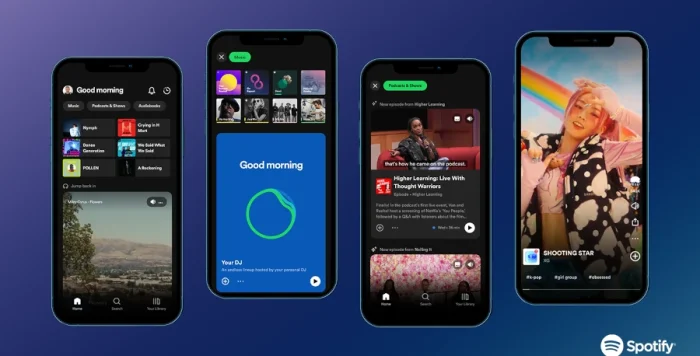ส่วนตัวแล้วไม่ได้เป็นผู้ใช้ Spotify แบบเข้มข้นนัก เลือกฟังเพลง (นานๆ ทีด้วย) ใน YouTube Music ด้วยเหตุผลว่าจ่าย YouTube Premium ไปแล้ว (ขายเหล้าพ่วงเบียร์นี่นา) ส่วน Spotify ใช้เพื่อฟังพ็อดแคสต์อย่างเดียวเท่านั้น แม้เห็นด้วยอย่างยิ่งว่าระบบเลือกเพลงของ Spotify ดีกว่ามากก็ตาม
ล่าสุดได้ฟังพ็อดแคสต์ Decoder สัมภาษณ์ Gustav Söderström ผู้บริหารใหญ่ของ Spotify (เป็น co-president ควบ CTO & CPO สามตำแหน่ง เท่ากับว่าเป็นรองแค่ CEO) มีประเด็นที่น่าสนใจดี ในแง่ระบบอัลกอริทึมของ Spotify
บทสัมภาษณ์นี้เกิดขึ้นในเดือนมีนาคม 2023 ในช่วงที่ Spotify ปรับ UI ครั้งใหญ่นับตั้งแต่มีแอพบนมือถือมา โดยเปลี่ยนหน้าโฮม หน้าหลักของแอพให้มี feed เป็นคลิปเพลงจากศิลปิน แนวว่า UI เหมือนกับ TikTok แต่ตัดคลิป MV ของศิลปินมาแสดงสั้นๆ มีเป้าหมายเพื่อให้ผู้ใช้รู้จัก (discover) เพลงใหม่ๆ มากขึ้น
การเปลี่ยนแปลงครั้งนี้ย่อมมีดราม่าพอสมควรจากผู้ใช้เก่าๆ ที่บอกว่าฉันต้องการฟังเพลงอย่างเดียว จะเอาคลิปมา ยัดเยียด นำเสนอฉันทำไม
เรื่องพวกนี้หากเราพักประเด็นเรื่องความคุ้นเคย ความชอบ-ไม่ชอบออกไปก่อน แล้วมามองด้วยเลนส์เรื่องการปรับปรุงผลิตภัณฑ์ (product improvement) จากสายตาของผู้สร้าง (ในที่นี้คือ Gustav ซึ่งเป็น Chief Product Officer โดยตรง และเป็นหนึ่งในพนักงาน Spotify 30 คนแรก อยู่มาตั้งแต่ยุคแรกๆ) เขามีวิธีคิดอย่างไร ถือเป็นการศึกษาเรื่อง Product Management ของแอพระดับโลกด้วย
Gustav เริ่มจากการเล่าว่า เวลาไปสัมภาษณ์ผู้ใช้ มักได้คำตอบว่าชอบฟีเจอร์ personalization แต่ถ้าขุดลงไปลึกๆ มันเป็นเรื่องของการค้นพบสิ่งใหม่ (discovery)
When we ask users what they love about Spotify, they say things like personalization and so forth, but if you drill down, what they really say is, “The more new things you show me and the more new things I find, the more I’m going to like this product.” It seems like the love for Spotify is very correlated, and hopefully causated to, the amount of discoveries we drive.
You subscribe value and love to the thing that helps you discover new things and have a better life. Discovery is kind of the lifeblood of Spotify.
ดังนั้น สิ่งที่ Spotify ควรทำมากที่สุดคือพัฒนา discovery ให้ดีขึ้น
ในอีกด้าน โลก UI เองหมุนไปทางฟีดคอนเทนต์แบบเล่นอัตโนมัติ (auto-play) ซึ่งเหมาะกับแอพฟังเพลงมาก เพราะการดูภาพปกอัลบั้มเพียงอย่างเดียว มันไม่รู้หรอกว่าเพลงเพราะแค่ไหน ต้องลองฟังดูก่อนถึงจะรู้
The truth is, evolution has happened the last few years with these feeds that auto-play content. It has converged on the most effective way to evaluate a new piece of content.
Not surprisingly, if you’re supposed to evaluate a piece of music by looking at cover art that may or may not be descriptive of the music, click through and start reading titles of songs that often have nothing to do with the music, you don’t even know the genre yet, and then click one of those titles and wait for one and a half minutes to get to the hook — that can’t be the best way to discover music. The best way to discover audio must be through audio.
เมื่อปัจจัย 2 อย่างนี้มาเจอกัน ในสายตาของเขาจึงคือว่าเป็นวิวัฒนาการของการค้นพบคอนเทนต์เพลงที่เวิร์คที่สุดในตอนนี้ และดีกว่าระบบ feed แบบเดิมของ Spotify ด้วย ดังนั้น Spotify จึงต้องยอมสยบ ยอมเปลี่ยนแปลง
The world didn’t just randomize into these auto-playing cards. It is evolution. It is the most effective way to quickly understand and evaluate lots of content. We have to respect those innovations. Spotify had a different type of feed, a two-dimensional feed, which was sort of state-of-the-art many years ago, but things change. They have to, and so does Spotify.
Gustav ยังพูดถึงอัลกอริทึมในการแนะนำเพลงใหม่ บอกว่าจริงๆ แล้วมันเป็นระบบ (systems) หลายอันที่ทำงานร่วมกัน แต่ในอีกทาง แอพจำเป็นต้องออกแบบ UI เพื่อให้สะท้อนว่าผู้ใช้ “ชอบ” อะไรจริงๆ ด้วย
If you think about it from the point of “the algorithm” — as they call it, even though it’s not an algorithm, it’s a ton of different systems, but to anthropomorphize a little bit — you need a user interface that can very effectively see what a user likes.
UI แบบเดิมที่แสดงปกอัลบั้มนั้นไม่รู้ด้วยซ้ำว่า เราไถฟีดที่มีปกอัลบั้มผ่านๆ แล้วเราเห็นภาพอัลบั้มนั้นหรือไม่ พอไม่รู้ก็เลยไม่แม่น มันเลยแสดงปกอัลบั้มเดิมๆ มาให้เราเห็นอีก ทั้งที่ในใจของเราไม่ชอบหรือไม่สนใจอัลบั้มนั้น
Imagine that you have our old homepage, where we would show cover art for a song, you would scroll past that, and the algorithm can’t even know if you saw it. Maybe you saw it; maybe you didn’t. Maybe you saw it, thought about it, evaluated it, and didn’t like it. It can’t know that, so it’s going to repeatedly show it again and again.
แต่ UI แบบใหม่ที่เป็น card-based และเล่นเพลงอัตโนมัติ รู้กระทั่งว่าเรา “ฟัง” เพลงที่เล่นขึ้นมานานแค่ไหน หากลองฟังสักครู่แล้วปัดผ่าน ก็ยืนยันชัดเจนว่าเราไม่สนใจ ระบบจะไม่นำเสนอเพลงนี้ขึ้นมาอีก
If you take one of these cards, when you see this, not only does the algorithm know you saw it, it even knows you heard it. It can know that if you listened to it for a while but then continued, that you should never see it again.
Gustav บอกว่าระบบ recommendation ที่ดี ไม่ได้แปลว่ามีอัลกอริทึมที่ดีกว่า แต่เป็นอัลกอริทึมเดิม + UI ที่มีประสิทธิภาพกว่าเดิมต่างหาก
The secret of why some of these products are so good at recommendations is not actually that they have better algorithms. It’s the same algorithms with a more efficient user interface.
ถึงแม้ UI แบบ feed ไปในทางเดียวกับแอพยุคใหม่ตัวอื่นๆ แต่วิธีการวัดผลของ Spotify ต่างออกไป โดย Gustav บอกว่าไม่ได้วัดผลเรื่อง “เวลา” ที่ใช้ใน feed เหมือนกับแอพโซเชียลอื่นๆ แต่เป็นการวัดผลว่าฟังเพลงใหม่ที่แนะนำนานแค่ไหน หรือเซฟไว้ฟังทีหลังด้วยหรือเปล่า
We’re doing something very different, where we’re not optimizing for time spent in the feed, but for how much you listen to or save for later.
เหตุผลเพราะโมเดลธุรกิจของ Spotify ไม่ได้มาจากโฆษณาเป็นหลัก แต่มาจากค่า subscription ดังนั้นวิธีคิดจึงต้องตั้งเป้าเรื่องการให้ผู้ใช้จ่ายเงินเป็นสมาชิกต่อไป (retention) ซึ่งสะท้อนมาจากปริมาณการฟังของผู้ใช้
These other companies, the ads make money by people being in the feed. We actually don’t. First of all, we’re mostly a subscription business, so we make money from retention, and you get retention when people listen to these long things. Even in the free tier, we actually don’t make money in the feed. We make money when someone later listens to that song and there is an ad in between that and the next song.
ดังนั้น วิธีการวัดผลของ Spotify จึงไม่ใช่เวลาที่อยู่บน feed เพราะธรรมชาติของ Spotify เป็นแอพที่ใช้เวลาอยู่เบื้องหลัง (a background application) ใช้เปิดเพลงทิ้งไว้ ไม่ใช่แอพเบื้องหน้าที่ผู้ใช้จดจ่ออยู่กับมันตลอดเวลา
Our incentives are not to keep you in the feed. Our incentives are to let you evaluate lots of content and put it in your library, so that when you get to that background moment, you have tons of things to listen to. That’s what we want to achieve. We would like you to quite quickly get through this feed because we don’t have a lot of foreground time in Spotify. We’re a background application.
ในต้นฉบับยังมีประเด็นเรื่อง usability / product อื่นๆ อีกหลายแขนง ใครสนใจศึกษางานสายทางนี้ก็แนะนำเป็นอย่างยิ่ง

/cdn.vox-cdn.com/uploads/chorus_asset/file/24504460/236569_Gustav_So_derstro_m_Spotify_AParkin.jpg)